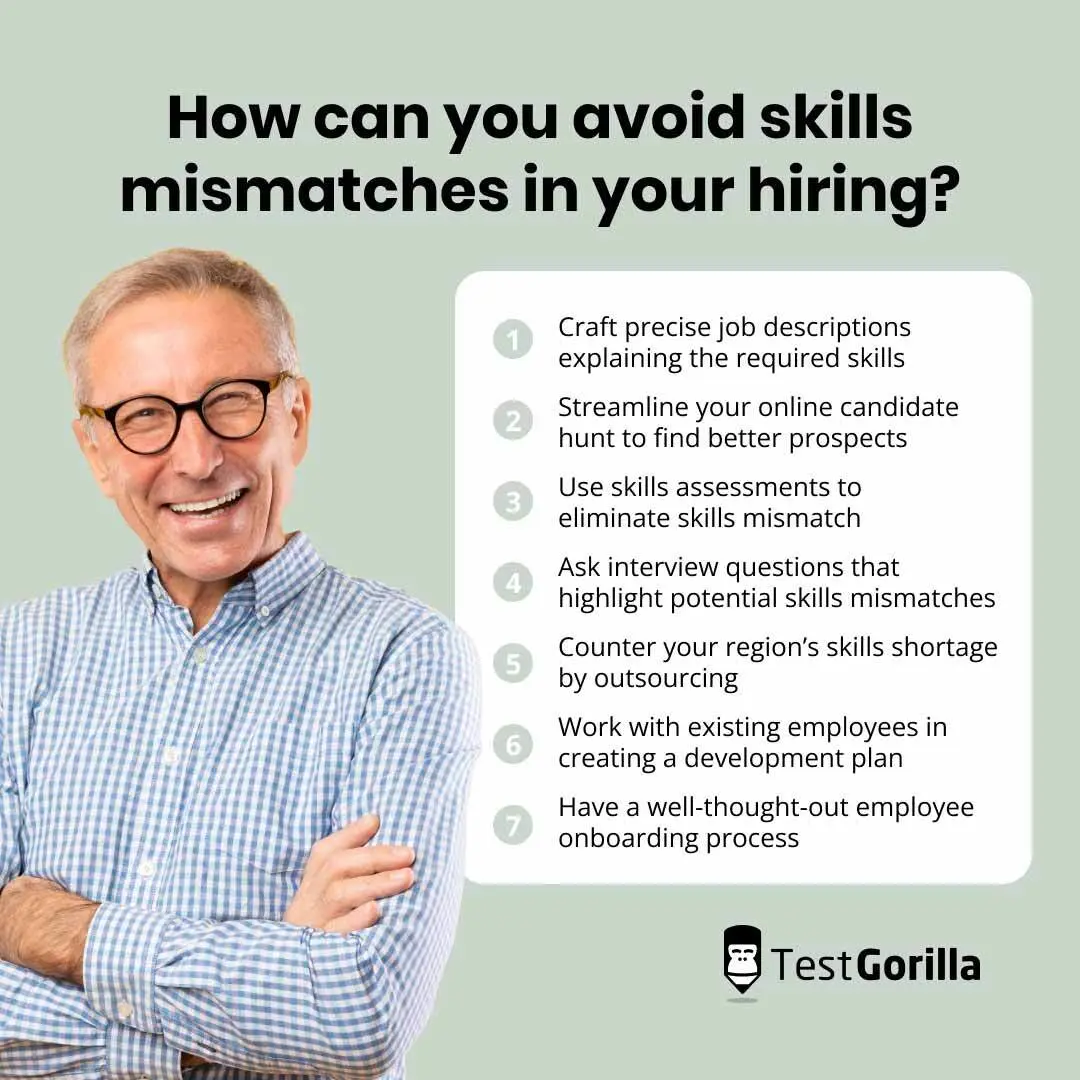Employees are a company’s most valuable asset but finding the right match for your company is never easy. Before you know it, you're hiring candidates with a skills mismatch and lamenting your failed hiring process.
A skills mismatch is the difference between the skills required to be successful in a position and the employee's skills occupying that position. An ill-matched employee will struggle with their tasks, gradually lowering their motivation and translating into disengagement. Eventually, they will resign, taking your hiring and training investment with them.
In this comprehensive guide, you'll learn where and how mismatches occur. You'll also discover actionable tips to identify skills mismatches and eliminate them from your hiring process.
Table of contents
What is a skills mismatch?
A skill mismatch happens when an employee or candidate lacks the skills needed for a specific job role.
This discrepancy can arise when an individual's competencies either fall short of or surpass the skill set necessary to effectively carry out the associated tasks of their position.
The negative consequences of a skills mismatch is far-reaching and can include job insecurity, limited career advancement opportunities, reduced income, decreased productivity, subpar work quality, employee burnout, and poor life satisfaction.
Within the workplace, a skills mismatch creates skills gaps that can significantly impact a business's performance and overall success. For instance, hiring errors cost companies nearly $15,000 per bad hire and a bad hire can cost your business up to 30% of the employee's first-year earnings.
How is a skills mismatch different from skills gaps and skills shortages?
A skills gap happens when there is a lack of the skills that employers look for in employees. This could occur on the individual level, when an employee doesn’t have all the skills required for a position, or on a group level, when a team or pool of candidates don’t have all the skills an employer would like.
A lack, for example, of management skills or public speaking skills would be a skills gap for a position that requires those skills. An employee with a skills gap needs to improve in certain areas and gain new skills to be able to perform their job at a satisfactory level.
On the other hand, a skills shortage occurs when the demand for a skill set exceeds its supply in a specific region. A skills shortage means that few people in a geographical area have the specialized skills required for a job. An example of this would be the concerning shortage of healthcare workers in Europe. The inability to meet the demand for skills is often the result of a shortage of training centers, changes in technological advancement, or a general lack of interest in that skill set or profession in the population.
Now, what about a skills mismatch?
Skills mismatch is an umbrella term that covers all problems related to the demand and supply of skills, whether undersupply or oversupply. By this definition, skill mismatches exist when there are skill gaps and shortages in the labor market.
Recommended reading: How to perform a skills gap analysis
Types of skills mismatches you might come across in your team
There are three main types of skills mismatch and understanding the characteristics of each will help you overcome the issues they present.
1. Horizontal skills mismatch
A horizontal skills mismatch occurs when someone who studied in one field works in another—and that’s why this type of mismatch is also also known as a field-of-study mismatch.
In horizontal skills mismatch, employees move laterally from one field of expertise to another. These employees have the right level of education but not in the right field of expertise.
Employing individuals from a different field of study comes with a risk. Informally taught candidates might not have as wide a breadth of skills as someone with formal training in that field.
Example of a horizontal mismatch
Someone who studied journalism, for example, but works in marketing can be classified as a case of horizontal skills mismatch.
2. Vertical skills mismatch
A vertical mismatch occurs when the level of expertise an individual possesses doesn’t match the level of skills required for a job.
In this type of mismatch, employees move vertically from their actual level of expertise to a position that requires either a higher or a lower level of skills. This type of skills mismatched is commonly referred to using terms of qualification:
Overqualified employees have a higher level of education or experience than what is required by the job.
Underqualified employees have a lower level of education or experience than what is required by the job.
Example of a vertical mismatch
Someone with a master’s degree working in a job that only requires a bachelor’s degree and someone without any leadership experience hired as a team leader are both examples of vertical skills mismatch. Both under- and overqualified individuals can experience disengagement with their jobs, leading to shorter terms with the company and a high employee turnover rate.
3. Skills obsolescence
Skills obsolescence occurs when a candidate or an employee's competencies fail to keep up with the rapidly changing demands of the job market. The most common types of skills obsolescence:
Technological obsolescence: This type occurs when advancements in technology render specific skills outdated. For example, employed typists who relied solely on manual typewriters faced technological obsolescence when computers and word processing software became the norm.
Industry-specific obsolescence: Industries evolve and change over time, and certain skills may become less relevant or even obsolete. For instance, a print journalist who fails to adapt to digital media and online publishing may experience industry-specific obsolescence.
Knowledge obsolescence: Knowledge and information can become outdated as new research, practices, and discoveries emerge. Professionals in fields like medicine or law need to continuously update their knowledge and skills to keep up with the latest advancements and legal precedents.
Why does a job mismatch happen?
Companies may hire mismatched individuals for several reasons. Some of the most common reasons for job mismatches are:
Certain fields of study are becoming unpopular in specific regions
Skilled workers in niche fields are retiring
Emerging technologies create jobs faster than the market can provide qualified candidates
Automation decreases the need for specific skills and makes them obsolete
Failing to identify skills mismatches during the hiring process
Not providing enough information about the requirements and responsibilities of a position to candidates
Candidates are looking to change fields, have new professional goals, and start a new career
Understanding where and why skills mismatches exist is half the battle. Let’s now review how you can avoid skill mismatches.
How to avoid skills mismatches when hiring
There’s not a lot you can do about the existence of skills matches but there’s a lot you can do to ensure they don’t slip into your hiring. The key lies in taking a strategic approach to your recruitment pipeline.
With the right checks and filters in place, you will not only avoid hiring mismatched candidates but also make your hiring process more efficient (both for you and your candidates) and save money down the line on employee training programs.
Let’s take it from the top, starting with the job description you need to create for a vacancy and move all the way to finding the perfect hire, all the while avoiding a skills mismatch.
1. Write precise job descriptions focusing on skills
Job descriptions are the guiding beacon of the entire hiring process. They communicate the kind of expertise you’re looking for so candidates matching your requirements can apply for the job. Job descriptions play a critical role in ensuring you get the right skills in your candidate pool.
As specialist recruiter Barry Deutsch explains, poorly written job descriptions are “the primary cause of hiring failure that occurs in over 50% of all executive and management hires.” Spending too much time developing job descriptions often feels like a waste of time. But effort here will go a long way in avoiding a skills mismatch.
So, how do you write better job descriptions?
For starters, choose specific job titles. Ambiguous titles or company jargon will confuse prospects. The title of “Marketing Ninja Superstar” would be puzzling if not intimidating when you’re looking for a “Digital Marketing Manager.”
Next, be sure to explain your expectations on skills and expertise on a mandatory-to-preferred scale. Giving a desired education level as the qualifier is not enough. While a degree can signal a certain level of knowledge, it’s not a good measure of a candidate’s proficiency in the job.
If you’re looking for experienced individuals, mention what you expect from that experience: Are there specific tools that candidates need to use? Do they need to have experience leading teams? Do they need to show results from a certain process?
Example of a skill-focused job description
Let’s look at an example of how you can apply these concepts to your job descriptions to take them from the general to the specific.
“We are looking for an Information Development Associate to join our Marketing team. You will be responsible for producing content for our company and should have:
3-5 years of experience in content development
a bachelor’s degree, preferably in communications, journalism, or similar fields.”
Sounds pretty decent right? Yet, it leaves a lot of room for interpretation and that’s where the skills mismatch can creep in. It’s not clear, for example, what type of content this person will be creating what kind of content experience they should have, or even what their responsibilities will be on the job. Let’s revise this with the required skills explained thoroughly.
“We are looking for a Content Writer to join our Marketing team. You will be responsible for writing and producing content for the company’s marketing efforts, including (but not limited to) blog posts, infographics, white papers, marketing emails, and newsletters. The ideal candidate will have:
3 – 5 years of experience in content marketing, with at least 1 year dedicated to B2B content creation
Strong knowledge of WordPress and the ability to optimize and publish content on the platform without guidance
Strong understanding of analytics tools like SEMRush and Ahrefs and the ability to use data to improve our content.
An understanding of content strategies and how they drive traffic
Familiarity with design tools like Photoshop will be a plus.”
You’ll notice we’ve removed the degree requirement and the preferred fields of studies from the revised job description. Yet, we’ve reduced the possibility of a skills mismatch occurring by precisely defining the previous experience required and the skills necessary to do the job day-to-day.
Taking the time to specify your expectations will result in a more targeted candidate pool which will reduce your workload since you won’t have to wade through a sea of unqualified candidates and free up your time to vet qualified candidates.
2. Streamline your online candidate hunt to find better prospects
Posting jobs online is by far the most effective way to reach candidates nowadays. But that doesn’t make it easy. A lot of your competitors are also looking for qualified candidates in your field, and you have to find a way to stand out from the competition.
With nearly 5.18 billion active internet users as of April 2023, fine-tuning your social media marketing efforts will quickly get you to the right candidates.
Make sure to include your detailed job description that clarifies the skill level and experience you’re looking for. This will ensure your applicant pool filters itself and you don’t have to seek through obvious mismatches.
Ask your marketing team to help you implement SEO best-practices to your careers page. This will help your job descriptions rank higher in search results when candidates look for jobs online. For this, you will have to look up key terms candidates use to search for jobs to use as keywords. If you’re looking for a PPC marketer, for example, your target prospects could be googling any of these terms: digital marketing jobs, PPC marketing jobs, or PPC search manager jobs. When you optimize for the right terms, you help qualified candidates find your website.
Platforms like LinkedIn and Facebook can further help avoid skills mismatches by targeting your job postings towards skilled candidates using demographic filters like age, gender, location, occupation, and interests. This way, your postings will only be visible to people who match your brief.
A stronger online presence will also help build your employer brand and allow you to showcase your company culture, benefits, and impact. This increases your chances of attracting in-demand candidates so you don’t have to settle for mismatched employees.
3. Use skills assessments to eliminate skills mismatch
A study by the University of Guelph revealed that nearly all candidates would be willing to deceive employers in some form during candidate screening. This includes lying, exaggerating, hiding information, or mirroring what the interviewer wants to hear during an interview.
How do companies mitigate this risk?
82 percent of companies now use pre-employment skills assessments to screen candidates. Skills assessments help you measure candidates’ abilities so you don’t waste time on in-depth reviews of mismatched employees.
Skills assessments can take various forms, from skills test to more elaborate test projects, and even job simulation exercises. For the initial screening stage, however, nothing works better than skills tests. Digitally available tests created by experts in their fields can help you quickly and objectively rank candidates, essentially eliminating skills mismatches.
4. Ask situational questions that highlight potential skills mismatches
Once you’ve filtered competent individuals through skills testing, it’s time to dig deeper into their experience through interviewing.
Interviews are time-intensive but can give a lot of insights into how well the candidate can apply their skills on that job. So what should you ask to find that out?
Behavioral and situational questions are the holy grail for interviews. They prompt candidates to talk about a specific situation and explain how they would handle it. Questions of this nature enable candidates to reflect on their past experiences and discuss their approach. You can test a host of skills like problem-solving, team management, project management, and critical thinking.
Here’s a list of contextual and situational interview questions to get you started:
Can you tell me about a time when your team was in a difficult situation and how you helped overcome it? This question tests leadership skills.
If an urgent project comes up, how would you adjust your current schedule and commitments? This will assess project management and organizational skills.
Can you tell me about a time when your superior wasn’t available and you had to make the call? Use this question to test decision-making skills.
Can you tell me about a time when you helped resolve differences in your team? Use this question to identify how they operate in a team environment.
Open-ended questions like these are great to recognize soft skills and encourage candidates to discuss scenarios in great detail. The added advantage is that you’d be able to ascertain their communication skills as well.
5. Address regional skills shortage by outsourcing
Skill shortages can be regional. When specific jobs spring up in certain parts of the world, fewer people may be able to provide the required skills either because of extremely high demand or because of a low supply.
Technology and high-speed internet have now made outsourcing a lot of jobs possible. You can hire anyone around the world via the internet, be it from another city or another continent. Freelancing websites like Fiverr and Upwork make it easy to find freelance talent, while remote job boards like WeWorkRemotely and Remotive.io help companies build remote teams.
Outsourcing helps widen your talent pool to find candidates with the required skills. It can take decades for a country to shorten its skill shortage so outsourcing continues to gain popularity. Hiring remote workers, freelancers, or partnering with outsourcing companies can help bridge the gap much quicker.
6. Work with existing employees in creating a professional development plan
Professional development plans serve as a powerful tool to bridge the gap between existing skills and the organization's evolving needs. Managers and the human resources team can work together in implementing professional development plans.
The effectiveness of professional development plans lies in their emphasis on growth, reskilling, and upskilling. Employees can enhance their existing skills and stay relevant in a changing environment through training, workshops, and mentorship.
Organizations can address skills mismatch and boost productivity, job satisfaction, and adaptability by fostering a culture of continuous learning.
Recommended reading: How to build professional development plans for your workforce
7. Have a well-thought-out employee onboarding process
A well-thought-out onboarding process helps address skills mismatch by providing comprehensive training, identifying skill gaps and fostering employee integration. Organizations can set their employees up for success and optimize overall performance by ensuring they possess the right skills from the start.
Your onboarding or preboarding process should also include mentorship or buddy programs, where experienced employees guide and support new hires. This helps facilitate employee integration, enhance their skills, and foster a sense of belonging within the organization.
Learn more: Improve your onboarding process with an onboarding checklist
Get better hires by addressing skills mismatch
A skills mismatch may not seem like a terrible thing at first: an overqualified candidate, you may think, will surely offer lots to a lower position, a candidate trained in a different field can bring in new ideas, and someone who lacks expertise can be eager to receive training and grow to meet your needs.
While all those scenarios can be true, the realities of skills mismatch show that the opposite is often what happens: overqualified employees get bored and become disengaged, employees from a different field struggle to understand the requirements of the job, and employees who lack experience quickly get overwhelmed.
Skills mismatch can be dangerous and turn out costly for your company. And while you can’t stop it from showing up in your recruitment efforts, there’s a lot you can do to eliminate skills mismatch and its negative consequences from your hiring pipeline.
When you craft precise job descriptions, screen candidates with skills tests, ask contextual interview questions, improve your onboarding process, and open up your talent pool to wider geographical areas, your chances of finding skilled workers for your open role go way up.
Eliminating skill mismatch through your hiring process will lead to better options, and better options lead to better hires. Better hires will be successful at their job for many years to come.
Avoid skills mismatch in your organization with skills testing through TestGorilla.
Related posts
Hire the best candidates with TestGorilla
Create pre-employment assessments in minutes to screen candidates, save time, and hire the best talent.
Latest posts
The best advice in pre-employment testing, in your inbox.
No spam. Unsubscribe at any time.

Hire the best. No bias. No stress.
Our screening tests identify the best candidates and make your hiring decisions faster, easier, and bias-free.
Free resources
This checklist covers key features you should look for when choosing a skills testing platform
This resource will help you develop an onboarding checklist for new hires.
How to assess your candidates' attention to detail.
Learn how to get human resources certified through HRCI or SHRM.
Learn how you can improve the level of talent at your company.
Learn how CapitalT reduced hiring bias with online skills assessments.
Learn how to make the resume process more efficient and more effective.
Improve your hiring strategy with these 7 critical recruitment metrics.
Learn how Sukhi decreased time spent reviewing resumes by 83%!
Hire more efficiently with these hacks that 99% of recruiters aren't using.
Make a business case for diversity and inclusion initiatives with this data.


















